College students come to the Sanctuary and learn lessons in compassion, caring for animals with special needs
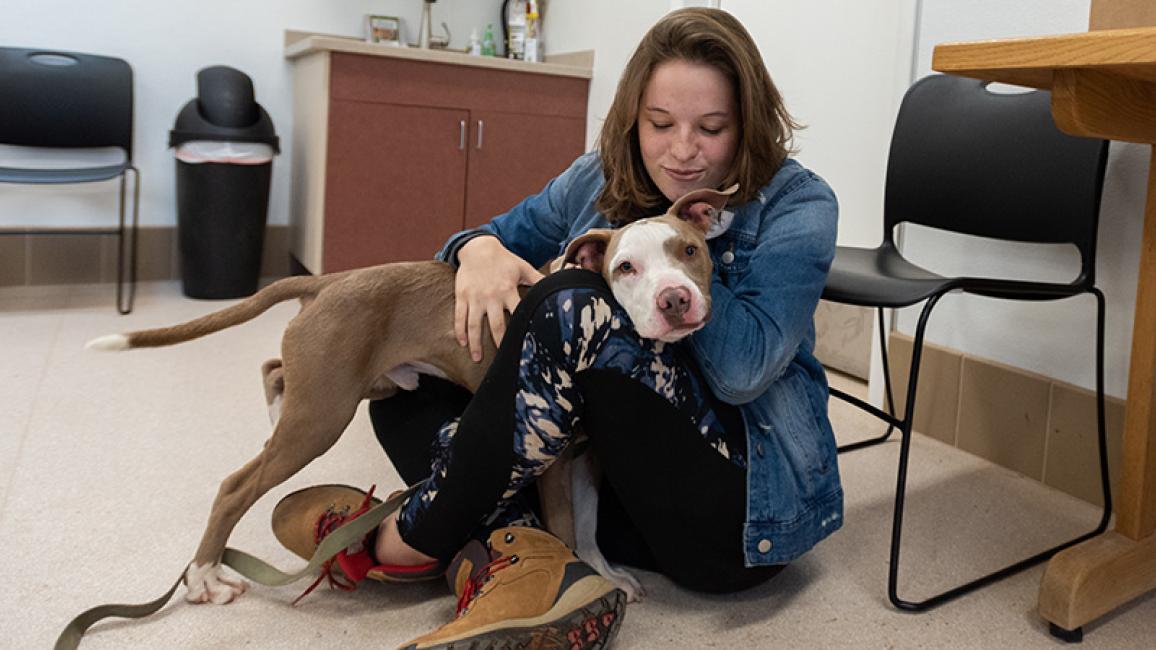
This summer, Best Friends was an interactive “living classroom” for 10 students from the University of North Florida (UNF) who spent 10 days studying and learning at the Sanctuary. The students attended presentations and demonstrations, volunteered at Dogtown, visited local Best Friends Network partner organizations and took dogs on hikes and sleepovers.
Most important of all, the students worked closely with animal behavior consultant Sherry Woodard, who developed and manages the Canines with Careers (CWC) program at Best Friends. Sherry taught the class on how dogs are assessed and selected for CWC and other rehabilitation programs (including prison dog training). Students also gained insight into dog body language and training, as well as the human-canine bond.
For some students, the visit to Best Friends was their first glimpse into the problems facing homeless pets across the country. Maiela Ruiz, a double major in criminal justice and psychology, says, “I didn’t know about the killing of animals (in shelters) when I came into this class. I was more interested in the human side of things. It was interesting and really inspiring to experience people’s passion for no-kill 2025. I’m much more interested in and open to animals now.”

Designing a criminology and criminal justice course
This was music to Dr. Jennifer Wesely’s ears. After an inspiring month-long trip to Best Friends Animal Sanctuary in the summer of 2017 and another trip the following year, the criminology professor knew she’d return as often as she could. But that wasn’t enough. She also wanted to find a way to bring her students with her to share in the experience, because she saw some golden learning opportunities for them.
As it turned out, there was a golden opportunity for Jennifer as well. UNF awards grants for professors to design and teach transformational learning opportunities courses — courses with unique learning opportunities that help students learn and grow both personally and professionally. Since that’s exactly what Jennifer wanted to do for her students, she designed a criminology and criminal justice course, “The Role of Canines in Inmate Rehabilitation,” and she won a grant.
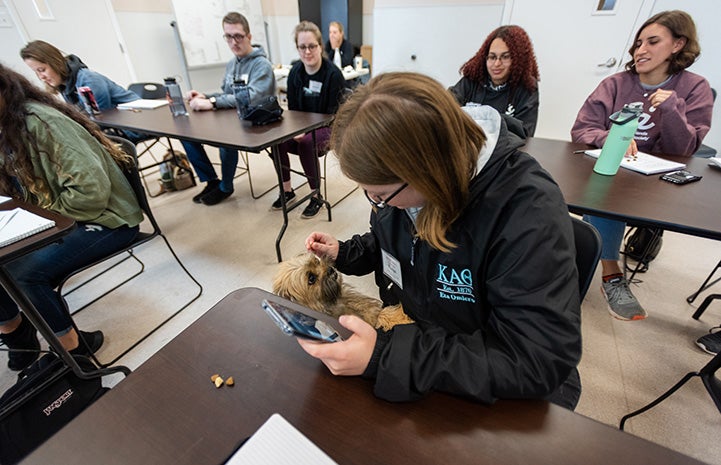
Asking good research questions
At least 20 students were interested in the class, but she had just 10 available spots and to earn one of them a student had to demonstrate a genuine desire to learn and be immersed in the firsthand experiences the course would offer, including a visit to Best Friends. Interested students completed applications and interviews, and Jennifer’s final selectees included one sophomore and a mix of juniors and seniors.
Sophie Gibbons, a psychology major, said: “There were so many reasons I wanted to take this class. I love dogs and wanted the chance to interact with them. I’m also interested in dog training and behavior analysis, and the dog and human connection.”
Jennifer challenged the students to prepare research questions to investigate during their time at the Sanctuary. Itzamarie Rivera, a psychology major, wanted to know how the Canines with Careers program has changed people’s views of dogs across the country and why CWC and programs like it are so important. She learned that the programs help remove the stigma around shelter dogs and pave the way for conversations about mental health. “Animals have a connection with people and a healing power beyond what doctors can do,” she says.
Brianna Woodall, a double majoring in criminal justice and psychology, was curious about how Sherry chooses dogs for assessment, and the standout qualities in the dogs she selects. She learned that one of the first considerations is the health of the dog, with mental health just as important as physical health.
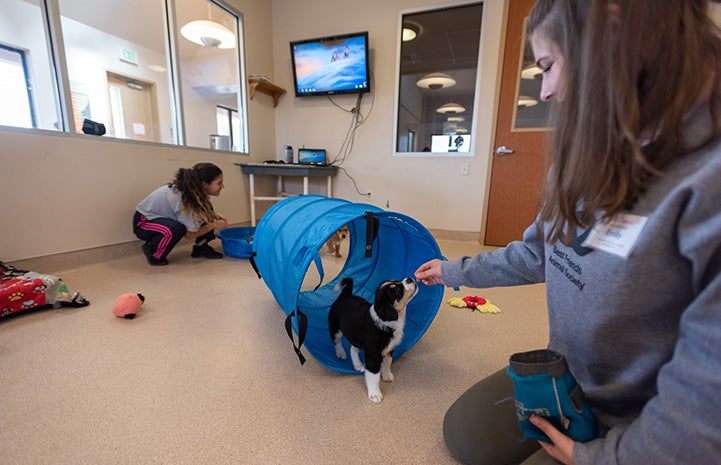
Giving dogs a choice and saving lives
Emily Scholz, a biomedical sciences major who plans to become a veterinarian, and Kaelyn Thomas, an anthropology major, looked at things from the animals’ perspective to determine how dogs are affected by CWC. What they found is that the program allows dogs to choose their own path in life. Since all dogs are individuals, some like to work and some don’t. Dogs accepted for the training want to work.
Dogs get to choose their own careers by showing their unique natural aptitudes and preferences in training. For example, some may be great service dogs for veterans with PTSD or children with autism, while others might be better at search and rescue. Kaelyn says that the dogs in the program have agency, which means they choose whether or not they want to work and how they want to work.
Both Maiela and Erin McClellan, a criminal justice major, wanted to know about the benefits of training shelter dogs as career dogs and how CWC and programs like it are helping the nation get to no-kill 2025.
“Every day many dogs are dying in shelters across the country, simply because they are homeless,” says Sherry. "At the same time, millions of people with psychiatric or physical challenges don’t have the career dog they need. Many search and rescue teams are also without qualified dogs, and thousands of military veterans suffering post-traumatic stress and children diagnosed with autism could benefit from having career dogs.”
With so much need for service dogs, programs that select and train shelter dogs can help save lives and get the nation to no-kill, while also assisting people who need career dogs.
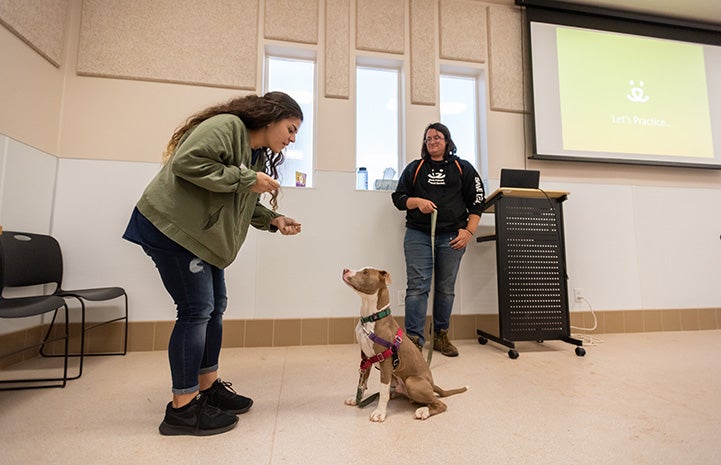
Lasting impressions
Besides finding answers to their research questions, the entire class (professor included) came away with some powerful lasting impressions.
“It was important for me to share this amazing experience with my students and interesting to see how they all processed it,” says Jennifer. “I learned a lot, too, as far as animal behavior and training, which will inform the volunteer work I do in my local community. For example, I learned ways to reach out to the community and how to build relationships and trust with people in order to help animals.”
For Frannie Nuccio (marketing major), Mikenzie Oldham (criminal justice and psychology) and Tyler Nagle (statistics and psychology), the experience drove home the fact that all dogs are unique individuals and that their behavior is highly contextual.
“You have to determine whether or not the behavior is appropriate for a specific time and place,” says Frannie. “People make judgements about dogs based on breed or color, but all dogs are individuals and (their behavior) can change,” says Tyler. And Mikenzie says, “You don’t know the true personality of a dog until you take him or her out of the shelter.”
“My thoughts have changed so much since I came into this experience. I didn’t realize (Best Friends) had so many animals with special needs or how well they are being cared for here,” says Erin.
Mikenzie sees a challenge for her entire generation: “Once we reach no-kill 2025, it will be our generation’s challenge and responsibility to keep it going.”
Read more about career dogs from Best Friends
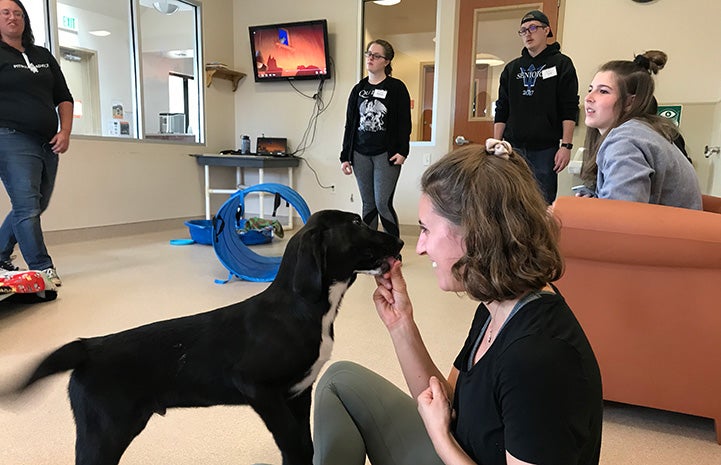
Photos by Kurt Budde and Jennifer Wesely